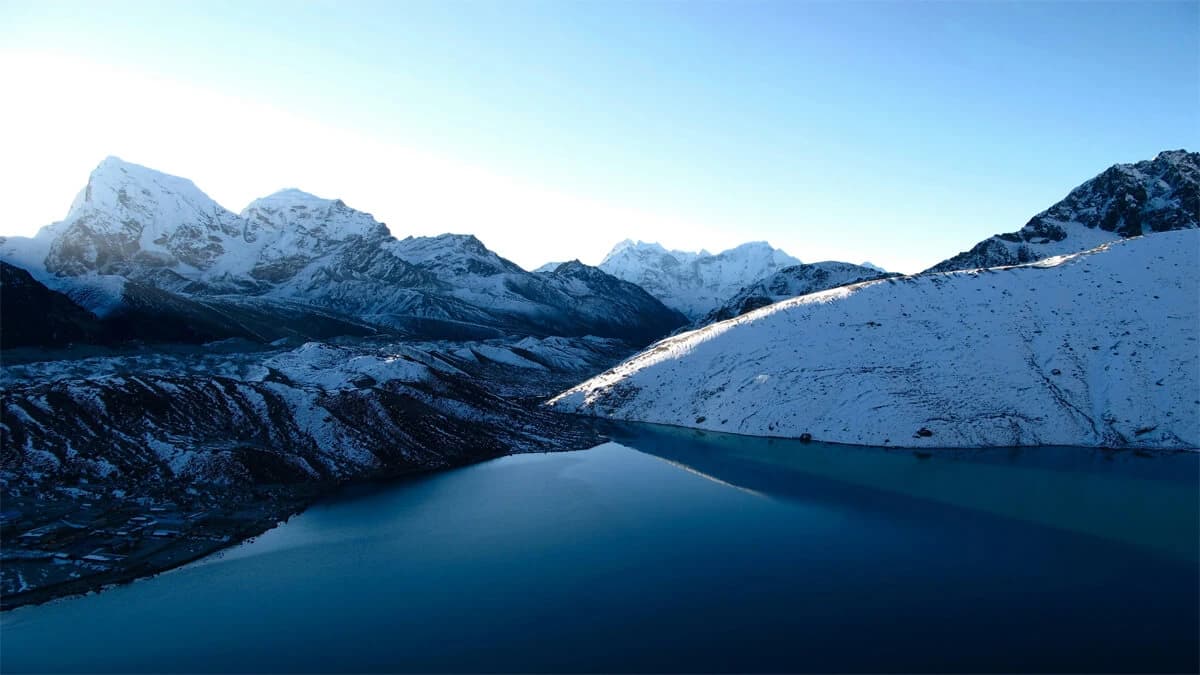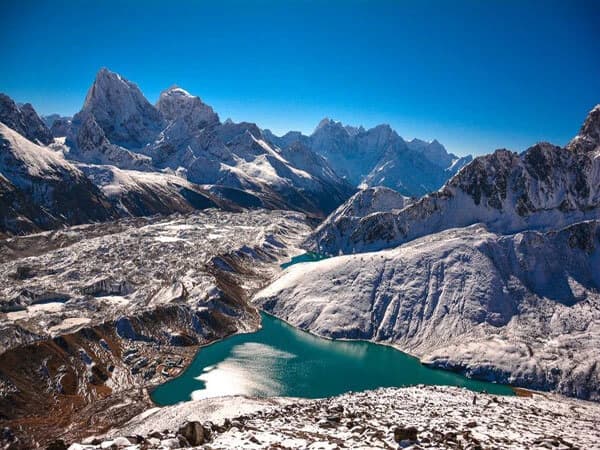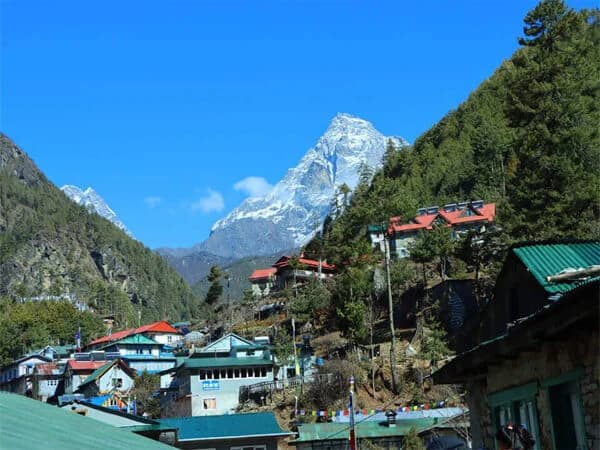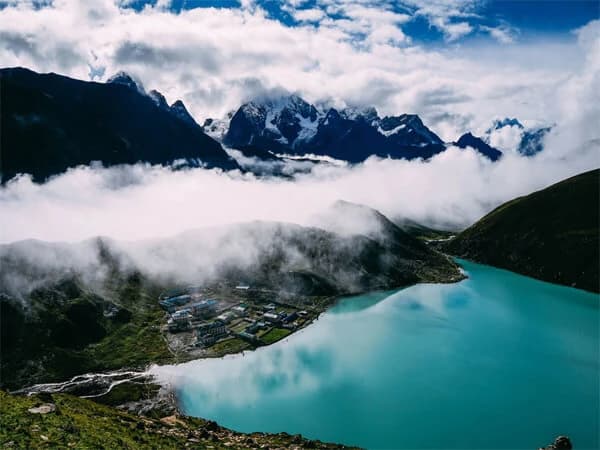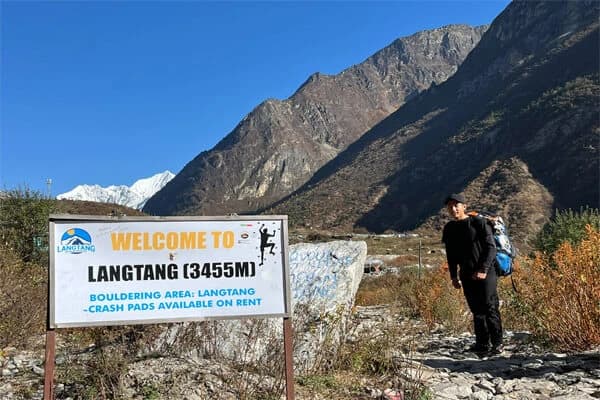Gokyo Lake trek is considered a moderately challenging trek in the Everest region. The trekking trail involves steep ascents, rocky path and high altitude terrain, reaching up to 5357 meters at gokyo ri. Those who is looking for Gokyo Lake Trek should be physically fit and perpared for long walking hours, and potential altitude related challenges. If you ready to incounter Gokyo lake trek difficulty you have to have proper acclimatization a steady pace, and good fitness level are essential to complete thes trek comfortably.
Gokyo Lakes Trek Difficulty
Are you looking for Gokyo lake trek, You must know Gokyo Lake trek difficulty is one of the major things to know. It takes you around the six natural glacial lakes interconnected with other 19 lakes of different sizes and shapes. This trek can also be further customized to Everest Base Camp trek or Everest Three High Passes trek as well.
The Gokyo Lake Trek is one of the most stunning treks in the Everest region of Nepal. It offers breathtaking views of Mount Everest and other peaks and transports you to a collection of stunning blue lakes deep in the mountains. For those seeking a peaceful, less-traveled path with scenic vistas, mountain views, and a little adventure, this trek is a fantastic option.
Before beginning, the difficulty of this trek should be understood. The trail reaches high elevations. Gokyo Ri is more than 5,300 meters above sea level. There is less oxygen in the air at this height, so trekking might be challenging. Additionally, you will walk for several hours every day, on rocky or steep trails. For this reason, it is important to be prepared.
We will explore the Gokyo Lake Trek's difficulty in detail in this blog. We'll examine the required level of fitness, weather, altitude, walking distance, and trail conditions. This guide will help you in determining whether the Gokyo Lake Trek is appropriate for you, regardless of your level of trekking expertise. This trek can be a memorable and safe experience with careful preparation.
The Sherpa ethnic villages reflecting a true spirit of Tibetan Buddhist culture and tradition are the rewards of this trek. Likewise, you will notice the flora and fauna of Sagarmatha National Park, one of the world heritage sites of Nepal. Hiking to the world’s highest placed hotel, Everest View Hotel is another beauty of this trip. While having breakfast or lunch, you can have the 360-degree view of Mt. Everest (8,848m) and other peaks as well.
Gokyo Lakes trek takes you towards Dole from Namche Bazaar, the Sherpa Capital by leaving the traditional Everest Base Camp trek route. By crossing Machhermo of Chhukung Valley, you will enter into Gokyo Lakes Valley (4,790m). There you will witness the beauties of the Himalayan valley and the Sherpa town. You will also hike to the most amazing vantage points of Everest trek.
Gokyo Ri (5,357m) trekking, the Fifth Gokyo Lake (4,956m) and Cho Oyu Base Camp (4,800m) are the most interesting factor of this trek. From these places, you will see the four eight-thousanders of the Mahalangur Himalayan Range. Mt. Everest, Mt. Lhotse (8,516m), Mt. Makalu (8,485m) and Mt. Cho Oyu (8,201m) including other peaks of the region are visible from here.
Challenges of High-Altitude Trekking in Gokyo
Trekking to Gokyo Lakes is a breathtaking experience. However, there are some significant obstacles to overcome, due to the high elevation. The trail takes you over 5,000 meters, where there is less oxygen in the air. Walking becomes more difficult as a result, and altitude sickness is a possibility.
Acute Mountain Sickness (AMS) is one of the main challenges. It may result in headaches, nausea, fatigue, appetite loss, and difficulty falling asleep. AMS can worsen and become hazardous if you climb too quickly without taking breaks. Acclimatization days, or rest days during which your body acclimates to the thin air, are crucial for this reason. To help their bodies adjust, trekkers typically spend an additional night at Machhermo or Namche Bazaar.
Walking more slowly and with less energy is another difficulty. Your body has to work harder at high altitudes to do basic tasks. You will become breathless even if you walk gently. The best course of action is to walk slowly, stay hydrated, and avoid smoking and alcohol.
Another factor is the weather. Temperatures decrease as you ascend, particularly at night. It can get extremely chilly in the Gokyo region, with mornings and evenings reaching freezing temperatures. You should bring a decent sleeping bag and warm clothing. Strong winds or unexpected rain can occasionally make trekking challenging.
There are fewer teahouses and rescue services due to the area's remoteness. It can take longer to get help if something goes wrong. Traveling with a guide and buying travel insurance that includes coverage for high-altitude trekking and emergency evacuation are important.
Lastly, one of the most difficult sections is the ascent up Gokyo Ri. It is really high and steep. Although many trekkers find it hard, the summit offers incredibly rewarding views.
Gokyo trekking is not particularly difficult, yet the great elevation presents additional challenges. You may lower the dangers and have a memorable and safe adventure by being well-prepared, walking slowly, and getting enough sleep.
What are the Gokyo Lakes Trek Difficulty factor?

Gokyo Lakes trekking is a must-do adventure activity while you are on Nepal visit. It prizes you with the lifelong memory of visiting the natural and cultural landmarks around the world’s highest peak. The glittering peaks, high altitude villages, green forests and Himalayan valleys are the major attractions of this trek.
In order to have lifelong experiences of being close to the Great Himalayas, you need to know: how difficult is Gokyo Lakes trek? There are many factors associated with Gokyo Lakes trek difficulty. Some of them can be altitude, trekking trails, trekking hours per day, total distance to cover, etc.
You find hundreds of Gokyo Lake trek difficulty blogs uploaded by hundreds of tourism agencies of Nepal. They all intend to provide you the detailed information that can be of your utmost use. However, this blog intends to justify the difficulty of Gokyo Lakes trek from a different perspective.
Yes, this blog doesn’t give you anything like metaphysical! All the information mentioned in this article is all about the aspects utilized to measure Gokyo Lakes trek difficulty. We have classified all the responsible factors into a few useful groups. Let’s take a quick look into those factors.
Geographical Factor
Geographical factor is the most responsible one to measure Gokyo Lakes trek difficulty. You start this trek right from Lukla (2,860m) and ending the first day’s trip to Phakding (2,610m). Next, you will move towards Namche Bazar (3,440m), which is also known as the Sherpa Capital.
As you have already reached the place higher than 3,000m, you had better take a spare day for acclimatization. Namche Bazar acclimatization day is kept for introducing you with the wonders of Everest region. You will hike to Everest View Hotel (3,880m), which is one of the world’s highest placed hotels.
From Everest View Hotel, you can witness the best panoramic view of Mt. Everest and other peaks. Imagine, having breakfast or lunch facing the world’s highest peak, isn’t it thrilling? You can also visit the Sherpa Museum to know more about the Sherpa culture and tradition as well as the 1953 Everest expedition.
From here, you will move towards Gokyo Valley (4,790m) by walking past Dole (4,200m) and Machhermo (4,470m). You have another acclimatization day here in this Sherpa Valley. So You will climb Gokyo Ri (5,357m) to have the most enchanting view of the glacial Lake Valley and 4 eight-thousanders.
You will also explore the 6 glacial lakes having the turquoise water reflecting the silvery mountains on it. The Fifth Gokyo Lake (4,956m) is a must-visit place in Gokyo Lake Valley. It shows you the valley and snowcapped peaks in their best appearance! If the team leader or itinerary supports, you can hike to Cho Oyu Base Camp for another series of lifelong experiences.
As Gokyo Lakes trek is one of the most frequented routes in Everest, the condition of the trails are fine. The total distance to cover is 92 kilometers through the rugged tracks without any high pass.
Physical Factor
Physical factor of Gokyo Lakes trek difficulty includes the difficulty that you face physically during this trek. The highest place you have to reach is Gokyo Lakes Valley (4,790m). As soon as you reach above 2,500m high place, there is probability of altitude sickness.
As you begin Gokyo Lakes trek right from higher than 2,500m, you need to be careful about Acute Mountain Sickness (AMS). You should take a few precautions like having enough food, water and rest as well as slow walk in the course of Nepal trekking. Keeping first aid box and listening to the trekking guide are other ways to minimize the risk of altitude sickness.
Other physical factors that might add to Gokyo Lakes trek difficulty are blisters, sore feet/joints, fatigue and the cough due to cold temperature. To heal such physical problems, you should keep a first aid box with the necessary medical kits. For cope with the fatigue, you should keep your body fully hydrated and walk with taking rest. To protect from extreme cold, you should wear the appropriate clothes.
If you have the previous experience of climbing or trekking in Nepal, it may not be much problematic. It is so because most of the trekking regions of Nepal are more or less similar in terms of the geographical situation. In this condition, you will follow all the preventive methods to avoid any physical assault or mishaps.
Temporal Factor
The total distance of Gokyo Lakes trek from Lukla is around 92 kilometers. And you need to walk for five days to reach the destination of this trek along the rocky trails through the Sherpa settlement areas. Similarly, it takes complete 3 days to trek down to Lukla from Gokyo Valley via Dole and Namche Bazar.
It means you have to cover more than 10 kilometers per day. To cover the given distance, you should walk for about 5/6 hours per day alongside the steep uphill and downhill trails. Walking for about 5/6 hours to measure approximately10 kilometers is not an easy task for the beginner trekkers. However, if you have already done trekking in Nepal, it is not much challenging.
Moreover, if you connect this trek with Everest Base Camp or Everest Three High Passes trek, you need to cover more than 130 kilometers. You should extend the trekking itinerary as well. More importantly, crossing three high passes all above 5,000m of Everest region is not everyone’s cup of tea.
To beat the challenges, you can prepare yourself right before beginning the trek. Developing a habit of regular walking and exercise is a good idea to cope with this trek difficulty. You can also take trainings from the authorized agencies that train you climbing and trekking in the Himalayas.
Social Factor
Social factor means the society and its concept about the international tourists visiting different places of Nepal. Your safety comes first for Nepal Trekking Routes although we get a little economic benefit from you. How safe is a trekking region for the international trekkers? is also a determinant of trek difficulty.
Therefore, to talk about Gokyo Lakes trek difficulty, you should know about the social factor of this region. It is sure that all the people of all the trekking regions of Nepal are friendly and cooperative to the foreigners. They believe in “Guests are Gods!” and correspond accordingly.
However, a handful of people may be negative regarding the international trekkers visiting their places. Especially, the people of the remote regions where there are not proper education facilities might have negative understanding about the tourists.
Nevertheless, talking about the people of Everest region, they are really friendly and welcoming to the international trekkers. They know the value of economic benefits they get from tourism industry. Many local organizations like youth clubs and Aama Samuha (Mothers’ Groups) are active in promoting tourism in Everest region.
The Sherpa people of the Khumbu region are very kindhearted and helpful to the tourists visiting their places. You can freely talk to them about the topics other than offensive. They will happily share the interesting stories behind their lifestyle, culture and tradition.
The Sherpa people are simpleminded, hardworking, honest and engaged in agriculture, trade and tourism industry. You will find the hospitality of the Shepra people to be amazingly welcoming! You can taste their typical food items talking with them. It also provides you an opportunity for cultural exchange after all!
Economic Factor
To focus on the economic burden you have to bear during trekking in Nepal, we have planned to talk about economic factor as well. Economic factor of Gokyo Lakes trek difficulty includes the cost you have to pay on different particulars. Apart from the cost for a trek package, there are some other miscellaneous expenses you have to bear.
You have to manage trekking gears and climbing gears to trek to different regions in different seasons of the year. Some of the climbing and trekking gears can be hired and returned after you complete the trek. For this, you can consult with our agency. And for this, you have to keep some amount as mortgage, which you will get back after returning their stuff.
Similarly, you should hire guide and porter to help you in case of emergency in the course of trekking. You should give some amount as incentives to the guide or porter although it is not mandatory. Some local tour operators in Kathmandu have a system of paying 10% of the total trip cost as incentives to the guide and porter by the customers. However, Nepal Trekking Routes doesn’t have such compulsive terms and conditions.
Likewise, you have to spend some amount in training for climbing and trekking from an authorized agency. Maybe, you have to purchase various tools to better prepare for trekking in Nepal. Last but not the least, you may have to pay extra amount to use miscellaneous goods and services in the high altitude places.
But don’t worry for extra burden as Nepal Trekking Routes is committed to provide the best quality services to the clients at the minimum cost. You can consult with us about this while booking Gokyo Lakes trek with us or even in the middle of the trip.
Environmental Factor
Of course, environmental factor also plays vital role in measuring Gokyo Valley trek difficulty. Environmental factor includes flora and fauna as well as temperature and weather of a particular trekking region.
Gokyo Lakes trek takes you around Sagarmatha National Park, which is one of the 10 UNESCO World Heritage Sites of Nepal. It is one of the highest placed conservation areas in the world. It is recognized for the Himalayan flora and fauna among which many are on the verge of extinction.
The major plant species found in the national park are oak, pine, spruce, fir and rhododendron. If you make Gokyo Lakes trek in spring, the entire region is embellished by colourful rhododendron flowers.
The park houses many endangered species of animals like snow leopard, Himalayan black bear, musk deer, red panda, etc. Likewise, many bird species including Himalayan pheasant, Nepal’s national bird are also found in this region. However, you don’t have any threat of wild animals when you are going on an organized trekking to Everest region. Your guide helps you avoid any possible threat of such encounter with wild animals.
Weather and temperature can sometimes be the cause for Gokyo Lakes trek difficulty. Spring and autumn are the best time for Gokyo Lakes trek, However, the trails may be slippery due to heavy rainfall in summer and heavy snowfall in winter. The thick layer of mists or fogs can disturb the visibility preventing you from having breathtaking views!
As Gokyo Lakes trek takes you up to Gokyo Ri (5,357m), there is no chance for any difficulty. The guide knows the probability of poor visibility, snowfall or rainfall in advance. Hence, you will delay or defer the climbing.
Psychological Factor
Finally, psychological factor plays the most vital role to determine Gokyo Lakes trek difficulty. Along with other preparations, you must be mentally committed to fight back the challenges during the trek. Your confidence level is the most important gear to complete this trek successfully.
When everything like the abovementioned factors, is all right, you will feel more confident. And your confidence level helps you best to minimize the difficulty of Gokyo Lake trek. Even if you are a beginner trekker, you can be mentally ready to fight back with the challenges of this trek.
Comparing Gokyo Lakes and Everest Base Camp Difficulty

In the Everest region, two popular treks are the Everest Base Camp (EBC) Trek and the Gokyo Lake Trek. Many trekkers are curious about which is more difficult. Each presents unique difficulties and is rather comparable in terms of difficulty.
The trek to Everest Base Camp is busier and more popular. Walking up to Kala Patthar (5,545 meters) and Everest Base Camp (5,364 meters) typically takes 12 days. The trail can get crowded during the busiest times of the year and is steep in some spots. The trails are well-traveled and simple to follow because so many people walk there.
There is a little more solitude and peace on the Gokyo Lake Trek. It also reaches high elevations. The highest point is Gokyo Ri (5,357 meters). Gokyo Ri is steep and high up, so climbing it is one of the hardest paths. Like EBC trek, the trek involves lengthy walks uphill and downhill.
Both treks are moderate to difficult. There are fewer teahouses, and Gokyo is less packed. This may feel more difficult. The trail passes through isolated locations with fewer people. Some trekkers decide to use both routes, going over the Cho La Pass between Gokyo and EBC. That adds to the difficulty of the trek.
Gokyo is the best option if you're looking for a more peaceful journey with breathtaking lake views. Choose EBC if you wish to get to the well-known Everest Base Camp. Both are similar in terms of difficulty; if you plan ahead and go slowly, you may enjoy either.
How Hard is the Gokyo Lake Trek?
The Gokyo Lake Trek ranges from moderately difficult to extremely difficult. While it is not the most difficult trek in Nepal, it is also not the simplest. Your level of fitness, prior trekking experience, and your body's ability to withstand high altitude will all play a role.
You will walk for 4-7 hours every day for 10-14 days during the trek. The trail ascends to Gokyo Ri from Lukla. That's quite a height increase. Breathing becomes more difficult as you go higher because the air is thinner. It becomes slower and more exhausting to walk uphill.
The trek does not include any technical climbing. Ropes and mountaineering expertise are not required. However, the trail is steep and rocky in some spots, and it does go up and down a lot. Climbing Gokyo Ri, a tall hill with a steep route, is the most difficult part. Because of the altitude, this ascent can be extremely difficult.
The cold temperature, particularly at night, presents another difficulty. Above 4,000 meters, it can get extremely chilly, even in the spring and fall. You need quality trekking equipment and warm clothing.
You can do this trek if you are physically active, walk frequently, or trek. With a good guide, rest days, and steady walking, beginners can also finish it.
Most people who plan carefully can complete the Gokyo Lake Trek, even if it can be challenging at times. The effort is well worth it because of the serene lakes and the scenery.
Best season to Trek Gokyo Lakes for Beginners
Choosing the ideal time of year is crucial if you're a beginner intending to trek to Gokyo Lakes. In the Himalayas, the weather is subject to sudden changes, and certain months are far better for trekking than others. Spring (March to May) and fall (September to November) are the ideal times of year for beginners.
Gokyo Lake Trek in Spring (March to May)
One of the most popular seasons is spring. The skies are clear, and the days are warmer and longer. The trail is colored by the blossoming rhododendrons and other flowers. There is less risk of rain or snow in the spring, and the weather is more stable. At this time, the vistas of Gokyo Lakes and the mountains are breathtaking.
Gokyo Lake Trek in Autumn (September-November)
Another wonderful season is autumn. Beautiful views of Everest, Cho Oyu, and other peaks can be seen when the summer rains stop and the skies clear up. The trail is dry and simple to walk on, and the temperature is cold yet nice. The safe circumstances and reduced risk of altitude sickness make autumn the ideal season for beginners.
Gokyo Lake Trek in Summer (June-August)
Summer is the Monsoon season. The trails are muddy and slippery due to the heavy rains. Bad weather causes flights to Lukla to be canceled, and clouds can block views of the mountains. For beginners, this is not the best time.
Gokyo Lake Trek in Winter (December-February)
The months of winter are extremely chilly. Particularly close to Gokyo Lakes and the Gokyo Ri ascent, the trail may be icy. When temperatures drop below freezing, teahouses in higher elevations could have to close. The path may also be blocked by snow. Only seasoned trekkers should attempt this season.
It is better to schedule your trek for spring or fall if you're a beginner. You can enjoy the greatest weather, safer conditions, and clearer trails during these seasons. You can enjoy your trek without having to deal with intense cold or rain, and the vistas are breathtaking. It's also easier to walk.
If this is your first trek in Nepal, choosing the appropriate season can make your Gokyo Lake trip safer and more pleasurable.
Acclimatization on the Gokyo Lake Trek
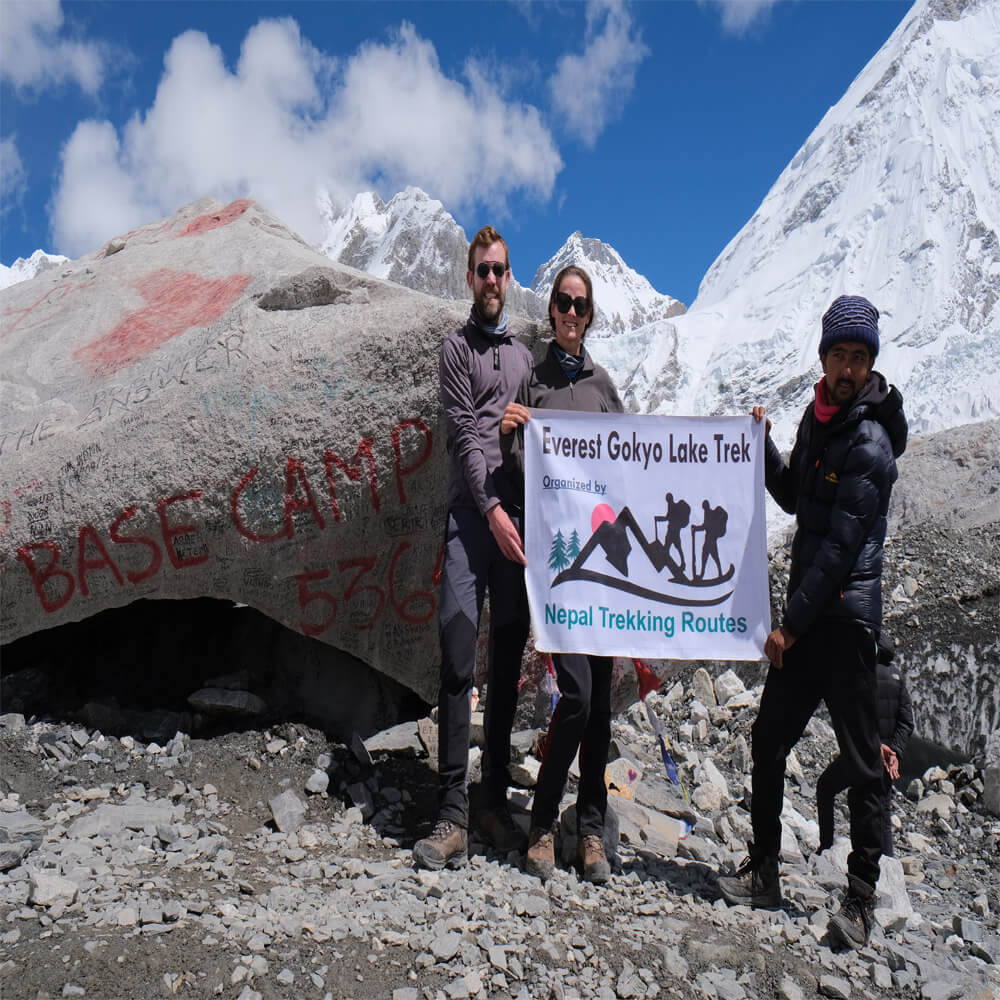 One of the most important parts of the Gokyo Lake Trek is acclimatization. It includes gradually helping your body acclimate to the high altitude to prevent illness. The air gets thinner and has less oxygen as you ascend higher in the mountains. You risk developing altitude sickness if your body does not have enough time to adjust to this altitude. Acclimatization is therefore essential to a successful and safe trek.
One of the most important parts of the Gokyo Lake Trek is acclimatization. It includes gradually helping your body acclimate to the high altitude to prevent illness. The air gets thinner and has less oxygen as you ascend higher in the mountains. You risk developing altitude sickness if your body does not have enough time to adjust to this altitude. Acclimatization is therefore essential to a successful and safe trek.
You should allow extra days for recovery because the Gokyo Lake Trek goes above 5,000 meters. At least one acclimatization day is included in trekking routes, like in Namche Bazaar (3,440 meters). You can spend the day visiting neighboring viewpoints like Khumjung village or the Everest View Hotel in this bustling Sherpa town. These little hikes allow your body to adjust to the altitude without going too quickly or too high.
The trail climbs steadily as you approach Dole, Machhermo, and Gokyo. Even though you won't be walking great distances every day, the altitude will still rise. It is crucial to eat healthily, get adequate sleep, drink lots of water, and move slowly. You should avoid smoking and alcohol since they hinder your body's ability to adjust.
To avoid altitude sickness, many trekkers also take a medication. However, careful walking and rest days are still required even with medication. Altitude sickness may cause symptoms including headache, nausea, fatigue, or appetite loss. Don't disregard these indicators. Stopping, resting, or even going lower is preferable. It can be risky to push yourself too hard at high altitude.
Acclimatization improves enjoyment of the trek in addition to its safety. You can appreciate the breathtaking views, serene lakes, and majestic peaks to the fullest when your body is strong and acclimated to the altitude.
Pay attention to your body and take your time. The Gokyo Lake Trek becomes a safer and more joyful experience with proper acclimatization.
Terrain and Trail Conditions in Gokyo Lake
The Gokyo Lake Trek passes across a variety of landscapes. There are flat, easy sections as well as rough, steep, and even icy ones. Being prepared for the trek and knowing what to expect from the path is important if this is your first time trekking in Nepal.
Lukla has a well-traveled trail, and the trek begins from here. You first go alongside rivers, through forests, and into villages. With a few steep hills, these early routes are mostly smooth. The trail becomes increasingly difficult as you ascend. You will walk through tiny pathways, suspension bridges, and stone steps. These bridges cross valleys and deep rivers. They are sturdy and safe, however, they do swing a little.
The path gets steeper around Namche Bazaar. Your steps may become slower as you begin to sense the difference in altitude. The landscape opens up after Namche as you move toward Dole and Machhermo. The path becomes rockier and dustier, and there are fewer trees. You might even walk close to cliffs and hillsides.
You will be trekking close to glaciers and lakes at high elevations after you enter the Gokyo region. Early in the morning or during the colder months, the trail may be icy and slick. One section of the trail may pass through Nepal's longest glacier, Ngozumpa Glacier. Its uneven terrain and abundance of rocks require careful walking.
The most challenging aspect of the terrain is climbing Gokyo Ri. The trail can be windy and rough, and it climbs rapidly. However, you can do it if you walk slowly and take rests. Special climbing equipment is not required, but sturdy trekking shoes are crucial. Trekking poles are quite beneficial while traveling downhill.
The Gokyo Lake trail offers a variety of ice, steep, rocky, and smooth slopes. It is crucial to be careful, take your time, and enjoy the scenery. Every step is worthwhile because of the breathtaking vistas of the mountains, lakes, and glaciers.
Climbing Gokyo Ri is one of the main attractions of the Gokyo Lake Trek. At roughly 5,357 meters above sea level, Gokyo Ri is a towering hill. Amazing views of four of the world's tallest mountains, including Mount Everest, Lhotse, Makalu, and Cho Oyu, can be seen from the top. However, it is difficult to reach the summit due to the great elevation.
The ascent to Gokyo Ri begins at four or five in the morning. This early start is done to witness the sunrise from the top. For most trekkers, the actual climb takes two to three hours. There are loose pebbles, gravel, and dust along the steep, zigzagging, ascending trail.
The thin air makes the climb even more challenging. The oxygen content is significantly lower at this altitude. While climbing, many trekkers experience fatigue, vertigo, or shortness of breath. It is crucial to walk slowly and take rests every few minutes. Remaining calm and drinking water are really beneficial.
Although physically challenging, most trekkers with general fitness can complete the climb. It requires patience and mental fitness. The latter portion of the climb can seem endless, particularly if you are cold and exhausted. However, all of the effort seems worthwhile once you get to the summit. The expansive vistas of the Gokyo Lakes and snow-capped mountains are truly remarkable.
Before your journey, practice climbing upwards to get ready for Gokyo Ri. Training with a backpack involves walking up hills or stairs. Additionally useful are trekking poles, which improve your balance and ease knee strain.
Gokyo Ri is both the hardest and the most rewarding portion of the Gokyo Lake Trek. You can reach the summit and observe one of the Himalayas' greatest vistas. You must take it slow, breathe deeply, and have an optimistic outlook.
Altitude Challenges in Gokyo Lake Trek
The steep elevation of the Gokyo Lake Trek is one of its main challenges. With Gokyo Ri reaching 5,357 meters, the trek puts you over 5,000 meters. Because there is less oxygen in the air at these altitudes, breathing may become more difficult. Many trekkers experience fatigue more rapidly and may have altitude sickness symptoms like headaches, nausea, or difficulty falling asleep.
If altitude sickness is not adequately treated, it can become a major issue. Even healthy and robust trekkers can be affected. Therefore, it is crucial to ascend gradually and give your body time to adapt. Acclimatization days, or rest days, are typically included in the trek so that your body can adjust to the thinner air before ascending higher. For instance, this is the reason why many people spend more time in Machhermo or Namche Bazaar.
Altitude sickness can be prevented by drinking less alcohol, eating healthily, and staying hydrated. The best course of action is to rest or descend to a lower altitude if symptoms worsen. You can better prepare if you are aware of the difficulties associated with high altitude. You can safely finish the Gokyo Lake Trek if you acclimate properly and move at a calm, steady pace. It all comes down to respecting the mountains and paying attention to your body as you go higher.
Gokyo Lakes Trekking Experience Level
The Gokyo Lakes trek is categorized as moderately difficult. While it is not the easiest trek in Nepal, anyone can complete it without being an expert or climber. However, prior trekking experience is highly beneficial. You will find this trek simpler to do if you have experience with multi-day treks, particularly those that take place at high elevations.
You won't need ropes or climbing equipment because the trail isn't challenging. However, there are some steep parts, high elevations, and long trekking days. Typically, you will walk for 5-7 hours per day. That can be challenging, particularly while going uphill at a high altitude or in the cold. Trekking can be difficult for those who have never done it before, both psychologically and physically.
Beginners who are physically fit and have a strong will can complete this trek. Many first-time trekkers have successfully finished it by being careful, training before the journey, and allowing enough time for acclimatization. A guide facilitates the trek by helping with altitude safety, motivation, and navigation.
Before attempting Gokyo, it's a good idea to start with easier treks like Ghorepani Poon Hill or Langtang Valley if you're not sure of your level of experience. However, if you're ready, Gokyo Lakes provides a fulfilling experience away from the crowd of people found on other Everest routes.
Physical Fitness Requirements for Gokyo Lake Trek
The Gokyo Lake Trek ranges from very difficult to extremely difficult. Professional climbing abilities are not necessary, but you must be in decent physical condition. You will walk for 5-7 hours every day, going uphill and downhill. There is less oxygen at higher altitudes, so breathing becomes more difficult. It is critical to be physically ready.
At least two to three months prior to your trip, begin walking or hiking to prepare for the trek. Strive for lengthy walks on hilly or uneven terrain (at least 10 km). Your leg strength and endurance will increase as a result of this. You may strengthen your heart and lungs by doing aerobic exercises like swimming, cycling, or jogging.
Your legs and knees will have to work hard because the trail may be hilly, rough, or covered in snow. The difficulty is increased if you carry a tiny backpack full of food, water, and warm clothing. For this reason, it is beneficial to practice with a backpack before the trek.
Being physically active and having a strong will are sufficient. You don't need to be an athlete. Many first-time hikers finish the Gokyo Lake Trek safely and joyfully if they walk slowly, get enough sleep, and eat healthily. The journey is made easier and more enjoyable by fitness
Conclusion: Gokyo lake trek difficulty
Considering all the factors responsible for trek difficulty, Gokyo Lakes trek is moderately challenging. Sometimes, the altitude and other times the weather and temperature can add up to the difficulty. Nevertheless, if you do an organized trekking with Nepal Trekking Routes, you can beat the unprecedented challenges of this trek.
To know more about Gokyo Lakes trek difficulty level, best time, itinerary and cost, contact us via different media available. Or, just click here.

